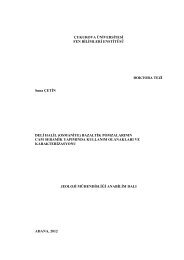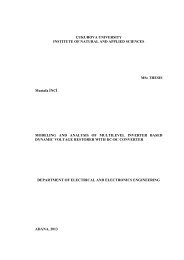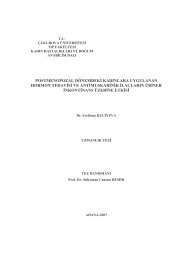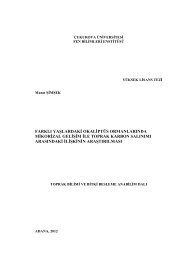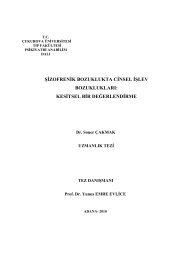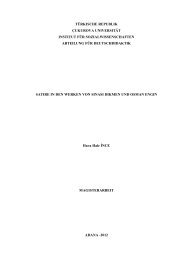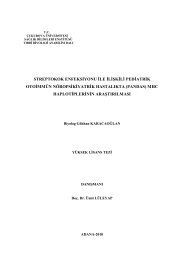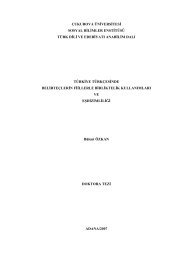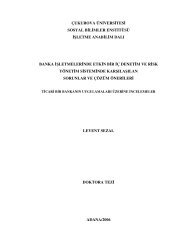situ hibridizasyon yöntemi i - Çukurova Üniversitesi
situ hibridizasyon yöntemi i - Çukurova Üniversitesi
situ hibridizasyon yöntemi i - Çukurova Üniversitesi
You also want an ePaper? Increase the reach of your titles
YUMPU automatically turns print PDFs into web optimized ePapers that Google loves.
ABSTRACT<br />
Evaluation of DNA Copy Number Changes and Chromosomal Aberrations in<br />
Melanocytic Tumors by Fluorescence In-<strong>situ</strong> Hybridization Method, Investigation<br />
of Its Differential Diagnosis and Prognostic Value<br />
Introduction-aim: Melanocytic tumors characterized by neoplastic proliferation<br />
of melanocytes and have highly wide and heterogeneous spectrum morphologically and<br />
genetically. Melanoma responsible for almost 60% of fatal skin tumors. Therefore,<br />
molecular studies for etiopathogenesis increasingly gain importance. In our study, we<br />
aimed to research the diagnostic value of four-colored fluorescent in <strong>situ</strong> hybridization<br />
method targeted of 6p25, 6q23, 11q13 and centromeric region of chromosome sixth at<br />
particularly melanocytic tumors which have diagnostic challenge. We aimed to<br />
determine differences of chromosomal aberrations in melanocytic nevus, displastic<br />
nevus, non-metastatic melanoma and metastatic melanoma and its place at biological<br />
behavior of malignant melanoma, comparing conventional morphological and<br />
prognostic criteria.<br />
Material and Method: In this study, we involved 74 melanocytic lesions, which<br />
diagnosed at Cukurova University School of Medicine Pathology Department. 17 cases<br />
(23%) had benign feature, 28 cases (38%) had borderline feature, 29 cases (39%) had<br />
malign feature. Borderline and malign lesions were selected from among the patients<br />
who have clinical follow-up. Fluorescence in <strong>situ</strong> hybridization procedure was<br />
performed on 3µm thickness sections of formaline fixed-paraffin embedded tissues<br />
taken from these cases. The results were examined by fluorescence microscope and<br />
numeric value of different four colors corresponding to copy numbers of genes were<br />
recorded.<br />
Results: Fluorescence in <strong>situ</strong> hybridization was negative in all of 17 melanocytic<br />
nevi cases; positive in 6 of 19 cases of borderline lesions which have diagnostically<br />
challenging; positive in 10 of 11 non-metastatic melanoma and positive in all of 18<br />
metastatic melanoma cases. The evaluation of test results were based on<br />
histopathological diagnosis as clearly benign and malignant lesions and were based on<br />
the characteristics of lesions that determined according to clinical behavior for<br />
borderline melanocytic lesion. Test sensitivity was 98,5% and specifity was 100%.<br />
Quantitative values of signal parameters compared as pairs in benign, borderline, nonmetastatic<br />
and metastatic groups. All parameters, except of 6q23 loss had statistically<br />
significant difference when compared benign and borderline groups, borderline and<br />
non-metastatic groups, but there was no statistically significant difference between nonmetastatic<br />
and metastatic melanom. Abnormal 6p25 and loss of 6q23 had strong<br />
correlations to prognosis, and 11q13 and 6q23 amplifications had weakly correlations to<br />
prognosis. 6p25 positivity was observed frequently at acral region (83,3%) and lower<br />
extremity (75%). Significant correlation were determined between 6p25 abnormality<br />
and 11q13 amplification with tumor diameter (p=0,001, p=0,046 respectively). There<br />
XI



